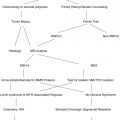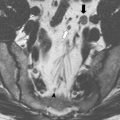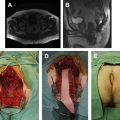Patients are not at risk of dying from a tumor that has been removed; they are at risk of dying from residual microscopic disease not removed at the time of operation. Thus, the goal of an adjuvant treatment, be it chemotherapy, radiation therapy, immunotherapy, or dietary and lifestyle manipulations, is to eradicate any residual, albeit microscopic, metastatic disease that might remain. Stage I disease carries an excellent prognosis, and at present there are no compelling data to support adjuvant chemotherapy for patients with this early stage. Stage II colon cancer also has a good prognosis after operation alone and represents the most complicated and contentious area in decisions regarding the use of adjuvant chemotherapy. Stage III colorectal cancer (TanyN 1–2 M 0 ) represents a group at a higher risk of recurrence, and this population is routinely given adjuvant chemotherapy in the absence of a medical or psychiatric contraindication.
Patients are not at risk of dying from tumor that has been removed; they are at risk of dying from residual microscopic disease not removed at the time of operation. Thus, the goal of an adjuvant treatment, be it chemotherapy, radiation therapy, immunotherapy, or dietary and lifestyle manipulations, is to eradicate any residual, albeit microscopic, metastatic disease that might remain. If the surgeon has truly “gotten it all,” then the patient is cured and there is no need or justification for subjecting the patient to any further treatment. It is because of the inability to determine definitively who does and who does not harbor micrometastatic disease that adjuvant therapy, predominantly chemotherapy, is administered to large numbers of patients with resected colon cancer, many of whom may have already been rendered disease-free by their operation.
Clinical stage remains the best prognostic indicator of the risk of what is somewhat inaccurately referred to as recurrence. Thus, stage is the best predictor of whether the patient harbors undetected microscopic stage IV disease. Stage is determined by the depth of tumor penetration into or through the bowel wall and the number of lymph nodes involved with cancer. Present recommendations are for the examination of an absolute minimum of at least 12 lymph nodes to assure accurate resection and staging. Adequate nodal examination reflects a combination of adequate nodal resection on the part of the surgeon, plus adequate nodal inspection on the part of the pathologist.
Stage I disease carries an excellent prognosis, and at present there are no compelling data to support adjuvant chemotherapy for patients with this early-stage disease. Stage II colon cancer also has a relatively good prognosis after operation alone and represents the most complicated and contentious area in decisions regarding the use of adjuvant chemotherapy. Stage III colorectal cancer (CRC) (TanyN 1–2 M 0 ) represents a group at a higher risk of recurrence, and this population is routinely given adjuvant chemotherapy in the absence of a medical or psychiatric contraindication. Extensive retrospective data have resulted in the segregation of patients with stage III cancer into 3 subgroups based on T category and N category within stage III (IIIA: T1–2, N1; IIIB: T3–4, N1; IIIC: T0–4, N2). The 5-year observed survival rates for these 3 subcategories were 60%, 42%, and 27%, respectively ( P <.001), with surgery alone indicating the heterogeneity of stage III cancer and the importance of this subcategorization in anticipating prognosis. Similar differences were calculated after stratification for treatment reporting a 5-year observed survival rate of 71%, 51%, and 33% with surgery plus adjuvant fluoropyrimidine chemotherapy for each subgroup, respectively. The data supporting the use of adjuvant therapy in patients with colon cancer are reviewed in later discussion.
Historical development of adjuvant therapy
Initial adjuvant trials in colon cancer were negative, due in large part to their being extremely undersized (as few as 30–50 patients per arm), based on unrealistically high expectations of the effect of chemotherapy. The first adequately powered study to address the question was the US Intergroup Trial INT-0035. In this trial, patients receiving 1 year of 5-fluorouracil (5-FU), plus the putative immunomodulator levamisole, experienced a 33% risk reduction compared with the surgery-only control group. In retrospect, levamisole has been shown to be an inactive agent; however, the trial was the first to give adequate doses of 5-FU to a large enough patient population to discern an effect. Subsequently, INT-0089 demonstrated that 6 months of adjuvant bolus 5-FU/leucovorin (LV) (Mayo Clinic Schedule or Roswell Park Schedule) showed a similar benefit to 1 year of bolus 5-FU/levamisole, with no further added benefit of concurrent addition of levamisole to an LV-containing regimen.
Studies of the oral fluoropyrimidines capecitabine and uracil and ftorafur (UFT) have demonstrated that each of these is an acceptable alternative to parenteral 5-FU/LV in the adjuvant setting. In a study powered to evaluate noninferiority of capecitabine versus the Mayo Clinic bolus 5-FU/LV schedule, noninferiority was demonstrated. Similar results (noninferiority of an oral fluoropyrimidine vs Mayo Clinic 5-FU/LV) were demonstrated in the National Surgical Adjuvant Breast and Bowel Project (NSABP) C-06 Trial for the oral agent UFT plus oral LV, although UFT is not commercially available in the United States.
Oxaliplatin-based combination chemotherapy regimens
In the Multicenter International Study of Oxaliplatin/5FU-LV in the Adjuvant Treatment of Colon cancer (MOSAIC) trial, 2246 patients (60% stage III and 40% stage II) were randomly assigned to receive either bolus plus infusional 5-FU/LV on an every-other-week schedule (LV5FU2), or the same schedule plus oxaliplatin, which results in a regimen known as FOLFOX-4. Updated efficacy results have now been reported ( Table 1 ). Five-year disease-free survival (DFS) was 73.3% for the FOLFOX group and 67.4% in the 5-FU/LV group (hazard ratio [HR] = 0.80; 95% confidence interval [CI], 0.68–0.93; P = .003). The 6-year overall survival (OS) rates were 78.5% for the FOLFOX group and 76.0% in the 5-FU/LV group (HR = 0.84; 95% CI, 0.71–1.00; P = .046); corresponding 6-year OS rates for patients with stage III disease were 72.9% and 68.7%, respectively (HR = 0.80; 95% CI, 0.65–0.97; P = .023). No improvement in OS was seen with the addition of oxaliplatin in patients with stage II disease.
| Stage III 6-y OS | Stage III 5-y DFS | Stage II 6-y OS | Stage II 5-y DFS | |
|---|---|---|---|---|
| FOLFOX | 72.9% | 66.4% | 85.0% | 83.7% |
| 5-FU/LV | 68.7% | 58.9% | 83.3% | 79.9% |
| P Value | P = .023 | P = .005 | P = .65 | P = .258 |
Toxicities were notable for a 12% incidence of grade 3 sensory neuropathy, which remained at grade 3 in 1% of the patients at 1-year follow-up. Long-term neurotoxicity is a major concern, with 27% of patients having some residual neurotoxicity 1 year after the end of treatment and 11% of patients having some residual neurotoxicity after 4 years of follow-up. It is reasonable to assume that toxicity, which has not resolved after 4 years, is likely to be permanent.
The NSABP C-07 trial evaluated the addition of oxaliplatin to weekly bolus 5-FU/LV (Roswell Park Schedule), randomly assigning 2407 patients with stage II (29%) or stage III colon cancer to half a year of 5-FU/LV (500 mg/m 2 bolus weekly for 6 of every 8 weeks) with or without oxaliplatin (85 mg/m 2 administered on weeks 1, 3, and 5 of every 8-week cycle). With median 34-month follow-up, 3-year DFS for the oxaliplatin/bolus 5-FU/LV (FLOX) arm was 77% versus 72% for bolus 5-FU/LV, with corresponding 21% risk reduction (HR 0.79). However, toxicity was prominent in both groups, with high incidences of grade 3 and 4 diarrhea. Hospitalization for diarrhea or dehydration was required in 5% of patients receiving oxaliplatin and 3% of the control group.
More recently, the combination of capecitabine plus oxaliplatin (CapeOx) has been compared with 5-FU/LV in the NO16968 trial. This trial, thus far reported only in abstract form, shows a statistically significant improvement in 3-year DFS (the prespecified primary end point of the trial) for the patients on the CapeOx arm. This result would seem to justify use of CapeOx as an alternative to FOLFOX or FLOX. It should be noted that CapeOx requires a highly reliable, motivated patient to assure adequate and accurate compliance with the medication schedule. Because patients require intravenous administration of oxaliplatin in the CapeOx regimen, it remains a matter of individual subjective judgment as to whether the fully parenteral or parenteral plus oral regimen is more convenient for the patient.
Given the results of the MOSAIC, C-07, and NO16968 trials, oxaliplatin plus a fluoropyrimidine should be regarded as standard adjuvant treatment for completely resected stage III colon cancer and should be regarded as an appropriate consideration for high-risk patients with stage II cancer. Head-to-head comparisons of the FOLFOX and FLOX regimens are not, and will never be, available. However, based on the apparent superior toxicity profile, the FOLFOX regimen is generally preferred. The unreported AVANT trial provides randomized comparison of a FOLFOX and CapeOx-based regimen.
Oxaliplatin-based combination chemotherapy regimens
In the Multicenter International Study of Oxaliplatin/5FU-LV in the Adjuvant Treatment of Colon cancer (MOSAIC) trial, 2246 patients (60% stage III and 40% stage II) were randomly assigned to receive either bolus plus infusional 5-FU/LV on an every-other-week schedule (LV5FU2), or the same schedule plus oxaliplatin, which results in a regimen known as FOLFOX-4. Updated efficacy results have now been reported ( Table 1 ). Five-year disease-free survival (DFS) was 73.3% for the FOLFOX group and 67.4% in the 5-FU/LV group (hazard ratio [HR] = 0.80; 95% confidence interval [CI], 0.68–0.93; P = .003). The 6-year overall survival (OS) rates were 78.5% for the FOLFOX group and 76.0% in the 5-FU/LV group (HR = 0.84; 95% CI, 0.71–1.00; P = .046); corresponding 6-year OS rates for patients with stage III disease were 72.9% and 68.7%, respectively (HR = 0.80; 95% CI, 0.65–0.97; P = .023). No improvement in OS was seen with the addition of oxaliplatin in patients with stage II disease.
| Stage III 6-y OS | Stage III 5-y DFS | Stage II 6-y OS | Stage II 5-y DFS | |
|---|---|---|---|---|
| FOLFOX | 72.9% | 66.4% | 85.0% | 83.7% |
| 5-FU/LV | 68.7% | 58.9% | 83.3% | 79.9% |
| P Value | P = .023 | P = .005 | P = .65 | P = .258 |
Toxicities were notable for a 12% incidence of grade 3 sensory neuropathy, which remained at grade 3 in 1% of the patients at 1-year follow-up. Long-term neurotoxicity is a major concern, with 27% of patients having some residual neurotoxicity 1 year after the end of treatment and 11% of patients having some residual neurotoxicity after 4 years of follow-up. It is reasonable to assume that toxicity, which has not resolved after 4 years, is likely to be permanent.
The NSABP C-07 trial evaluated the addition of oxaliplatin to weekly bolus 5-FU/LV (Roswell Park Schedule), randomly assigning 2407 patients with stage II (29%) or stage III colon cancer to half a year of 5-FU/LV (500 mg/m 2 bolus weekly for 6 of every 8 weeks) with or without oxaliplatin (85 mg/m 2 administered on weeks 1, 3, and 5 of every 8-week cycle). With median 34-month follow-up, 3-year DFS for the oxaliplatin/bolus 5-FU/LV (FLOX) arm was 77% versus 72% for bolus 5-FU/LV, with corresponding 21% risk reduction (HR 0.79). However, toxicity was prominent in both groups, with high incidences of grade 3 and 4 diarrhea. Hospitalization for diarrhea or dehydration was required in 5% of patients receiving oxaliplatin and 3% of the control group.
More recently, the combination of capecitabine plus oxaliplatin (CapeOx) has been compared with 5-FU/LV in the NO16968 trial. This trial, thus far reported only in abstract form, shows a statistically significant improvement in 3-year DFS (the prespecified primary end point of the trial) for the patients on the CapeOx arm. This result would seem to justify use of CapeOx as an alternative to FOLFOX or FLOX. It should be noted that CapeOx requires a highly reliable, motivated patient to assure adequate and accurate compliance with the medication schedule. Because patients require intravenous administration of oxaliplatin in the CapeOx regimen, it remains a matter of individual subjective judgment as to whether the fully parenteral or parenteral plus oral regimen is more convenient for the patient.
Given the results of the MOSAIC, C-07, and NO16968 trials, oxaliplatin plus a fluoropyrimidine should be regarded as standard adjuvant treatment for completely resected stage III colon cancer and should be regarded as an appropriate consideration for high-risk patients with stage II cancer. Head-to-head comparisons of the FOLFOX and FLOX regimens are not, and will never be, available. However, based on the apparent superior toxicity profile, the FOLFOX regimen is generally preferred. The unreported AVANT trial provides randomized comparison of a FOLFOX and CapeOx-based regimen.
Stay updated, free articles. Join our Telegram channel

Full access? Get Clinical Tree






